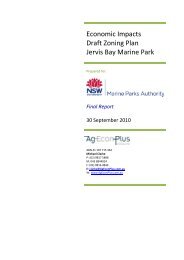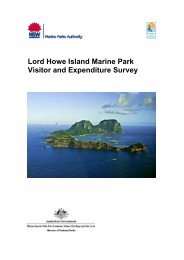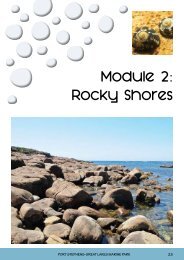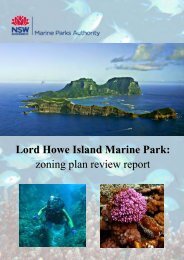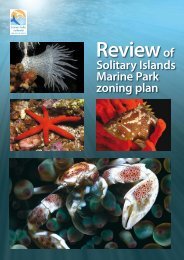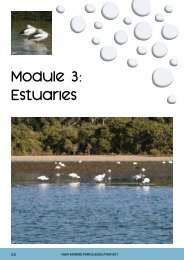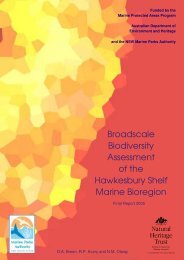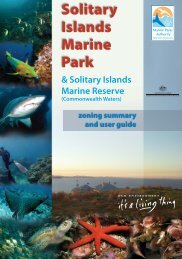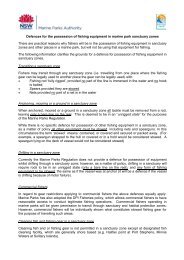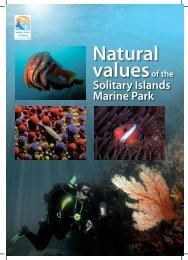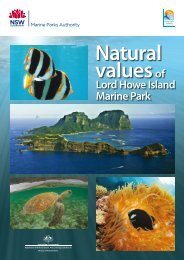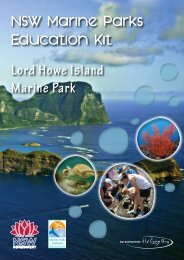community composition with maps of seabed habitats will allow more accurateassessment of zoning to represent diversity (Williams and Bax 2001).As reef fish assemblages can be highly variable at different spatial scales such asacross or along a reef, and at different temporal scales (e.g. seasonal variation), it isimportant to adequately survey patterns of abundance within each marine park. Largerscales of variation may reflect factors such as past and present biogeographic andoceanographic patterns (Bellwood and Wainwright <strong>2002</strong>), latitude (Meekan and Choat1997), geology (Harman et al 2003), temperature and productivity (Leathwick et al2006). In contrast, spatial variation in assemblage structure of fishes at smaller spatialscales (100s–1000s of metres) can be driven by complex interactions between manyfactors including habitat (Connell and Jones 1991, Curley et al <strong>2002</strong>), environmentalgradients (e.g. aspect, exposure, turbidity, light, depth) (Warner et al 2000), andecological processes (Shima 2001). Such ecological processes can also influence localassemblages through mechanisms associated with population dynamics and species’life histories. These include: dispersal, recruitment and settlement; densitydependence, competition and predation; and trophic-dynamics and partitioning. Toinvestigate all potential factors and interactions between them is not feasible.To improve the spatial biodiversity information available for zoning plans in SolitaryIslands and Jervis Bay <strong>Marine</strong> <strong>Parks</strong>, comprehensive surveys over the past sevenyears built on surveys conducted before the current zoning plans commenced. In theSolitary Islands <strong>Marine</strong> Park, surveys have focused on reef fishes and molluscsprimarily outside estuaries; macroinvertebrates in estuaries and other fauna groupsincluding some echinoderms (marine invertebrates such as a starfish or sea urchins)and amphipods at specific locations. Similarly, work in the Jervis Bay <strong>Marine</strong> Park hasfocused on habitat research in shallow and intermediate-depth reefs usingassemblages of fish, invertebrates and algae, and soft-sediment habitat in estuariesusing polychaetes, molluscs and crustaceans.2.1 Solitary Islands <strong>Marine</strong> ParkThe Solitary Islands <strong>Marine</strong> Park experiences the overlap of tropical and temperatebiogeographic zones on the east coast of Australia (Zann 2000a). Tropical offshore andtemperate inshore currents, combined with the varied habitats of extensive reef andoffshore islands, have resulted in a biologically diverse system, with a spatially complexmix of species, assemblages and habitats. Key habitats include intertidal and subtidalreefs, soft sediments, seagrass beds, mangroves, saltmarsh, and pelagic waters, all ofwhich support distinct assembledges of plants and animals.2.1.1 Habitat knowledgeSeveral seabed habitat mapping projects in the Solitary Islands <strong>Marine</strong> Park since<strong>2002</strong> build on earlier work on mid-shelf and offshore reefs (Mau et al 1998) and inshorereefs (see details in Natural values of the Solitary Islands <strong>Marine</strong> Park) (MPA 2008a).Habitat mapping refers here to a range of spatial data in a Geographical InformationSystem (GIS) primarily from remote sensed imagery and often a bathymetric modelthat is ground truthed to generate a habitat map within a hierarchical classificationscheme.In brief, mapping of estuarine aquatic macrophytes (seagrass, mangrove andsaltmarsh) from aerial photographs was completed in this marine park as part of theComprehensive Coastal Assessment (West et al 2006). Mangrove diversity wasexamined further in the estuaries by Taffs (2006). This recent mapping has enabled thecomprehensiveness of the current zoning arrangements in the estuaries to beassessed, as the full extent of each vegetated habitat was mapped. Selected seabed4 Solitary Island and Jervis Bay <strong>Marine</strong> <strong>Parks</strong> <strong>Research</strong> <strong>Project</strong>s <strong>Summaries</strong> <strong>2002</strong>–<strong>2009</strong>
habitats outside the estuaries of the marine park were also mapped as part of a largerstatewide swath acoustic mapping program.The acoustic mapping revealed extensive subtidal rocky reefs throughout the marinepark, and while many reefs are adjacent to the mainland and offshore islands, othersare discrete subtidal features. A comprehensive description of the distribution, extentand structure of seabed habitats in the Solitary Islands <strong>Marine</strong> Park is provided in NSWMPA (2010a).Outside the estuaries, subtidal habitats are categorised into consolidated (reef) andunconsolidated (primarily sand dominated) areas, within three depth zones: shallow(0–25 m), intermediate (25–60 m) and deep (more than 60 m). The above informationwas combined to provide a map of known distribution of seabed habitats in the SolitaryIslands <strong>Marine</strong> Park (Figure 1).More recent assessment of the patterns of reef fish assemblages indicates threedistinct assemblages occurred on reefs 50 m supporting theneed for a habitat classification scheme based on these three depth categories. Inaddition, habitats have also been separated into subgroups based on their distanceoffshore: inshore (less than 1.5 km offshore), mid-shelf (1.5–6 km), and offshore (morethan 6 km offshore) (Malcolm et al 2010). For the purposes of reviewing the extent ofspecific habitats in each zone type these revised habitat classes have been used.Intertidal work on boulder habitat has shown them to be a relic habitat of higherHolocene sea-levels. Two types of boulder habitat were identified: boulder pockets andthe less common boulder beaches (Wilkes <strong>2009</strong>).2.1.2 Biodiversity assessmentA number of broad biodiversity studies have been conducted within the Solitary Islands<strong>Marine</strong> Park over the past two decades on algae (Millar 1990, 1998), corals (Smith andSimpson 1991, Veron 1993, Harriott et al 1994, Wilson 1998, Smith and Edgar 1999),fishes (Malcolm et al 2010; Malcolm et al in press; Malcolm et al in review b) and softsedimentassemblages (Smith and Rowland 1999). Mammals, reptiles and birds arealso distinct fauna – permanent residents, seasonal visitors or individuals passingthrough. A summary of the marine biodiversity in the NSW north coast region ispresented in Rule et al (2007).Building on previous research, surveys since <strong>2002</strong> have examined the biologicaldiversity of particular habitats, communities or taxonomic groups. Many of these alsodescribe spatial and temporal patterns of diversity, abundance and communitycomposition.Further details of the flora and fauna associated with defined habitats in the marinepark are in Natural Values of the Solitary Islands <strong>Marine</strong> Park (NSW MPA 2008a). Asummary is presented below.Solitary Island and Jervis Bay <strong>Marine</strong> <strong>Parks</strong> <strong>Research</strong> <strong>Project</strong>s <strong>Summaries</strong> <strong>2002</strong>–<strong>2009</strong> 5



